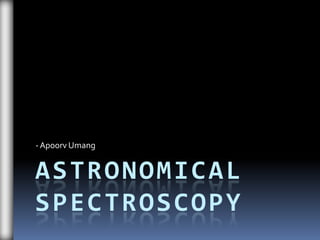
Astronomical Spectroscopy
- 2. Spectroscopy
- 3. Spectroscopy Spectroscopy is a technique in which the visible light that comes from objects (like stars and nebulae) is examined to determine the object's composition, temperature, motion, and density. A representation of the spectrum of a compound
- 4. When something is hot enough to glow (like a star), it gives us information about what it is made of, because different substances give off a different spectrum of light when they vaporize. Each substance produces a unique spectrum, almost like a fingerprint. In addition, different cool gases will absorb different wavelengths of light and generate a signature spectrum with dark lines at characteristic places. Because of this, we can determine the composition of gases by observing light that has passed through them. The spectrum of Hydrogen gas
- 7. Astronomical Spectroscopy It is the use of spectroscopy in astronomy. In this, spectroscopy is used to derive many properties of stars and galaxies, such as their composition and movement. Astronomical spectroscopy began with Isaac Newton's initial observations of the light of the Sun, dispersed by a prism. Dispersion of light by a prism
- 8. However, when the spectrum was closely examined, the rainbow was found to be interrupted by hundreds of tiny dark lines (called Fraunhofer lines). These lines showed that some wavelengths are being absorbed by gases in the outer atmosphere of the Sun, and from this, we can determine which elements are in the Sun's atmosphere. Extremely high resolution spectrum of the Sun
- 9. Discovery of Helium In 1868, Sir Norman Lockyer observed strong yellow lines in the solar spectrum which had never been seen in laboratory experiments. He deduced that they must be due to an unknown Norman Lockyer spectroscope element, which he called helium, from the Greek helios (sun) It was only 25 years later (in the 1890s) that Helium was detected on earth. Helium in Solar Prominences
- 10. Spectral types The spectral type of stars is a system of classification of stars based on the stars' spectra that correlate with each star's surface temperature and color. Stars range from blue and hot to red and cool. The seven spectral types are: O, B, A, F, G, K, and M (from hottest to coolest). Each of these letters is divided into 10 numerical classes, from hotter to cooler: The sun’s spectral type is G2 0, 1, 2, 3, 4, 5, 6, 7, 8, an d 9.
- 11. Nebulae In earlier times, the word ‘nebula’ was used to describe any fuzzy patch of light that didn’t look like a star. However, when their spectra were studied, it was found that many of these nebulae, such as the Andromeda Nebula, had spectra that looked similar to stellar spectra, and these turned out to be galaxies.
- 12. Others, such as the Cat’s Eye Nebula, had very different spectra – consisting of a few strong emission lines rather than the continuous spectrum seen in the sun. These lines did not correspond to any element seen on Earth, and astronomers suggested them to be from a new element nebulium. However, later studies showed that because of the extremely rarified vacuum found in nebulae, atoms The Cat’s Eye Nebula behaved differently, leading to the strange spectrum.
- 13. Galaxies Galactic spectroscopy has led to many fundamental discoveries. Edwin Hubble discovered in the 1920s that, apart from the nearest ones (those in what is known as the Local Group), all galaxies are receding from the Earth. The further away a galaxy, the faster it is receding. This was the first indication that the universe originated from a single point, in a Big Bang.
- 14. Planets and Asteroids Planets and asteroids shine only by reflecting the light of their parent star. The reflected light contains absorption bands due to minerals in the rocks present for rocky bodies, or due to the elements and molecules present in the atmospheres of the Gas giants.
- 15. Asteroids can be classified into three main types, according to their spectra: the C-types are made of carbonaceous material, S-types consist mainly of silicates, and M-types are 'metallic'. C- and S-type asteroids are the most common.
- 16. Quasars The distant nature of quasars were discovered in the early 1960's, when their spectral lines were noted to be substantially-shifted redder than they should normally be. This redshift was attributed to the recession (speeding away) of quasars from us. Thus, it was concluded that quasars were the most distant objects known to us.
- 17. Thank You